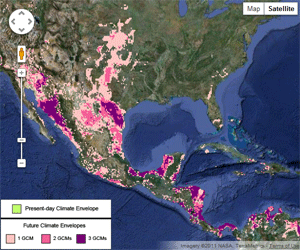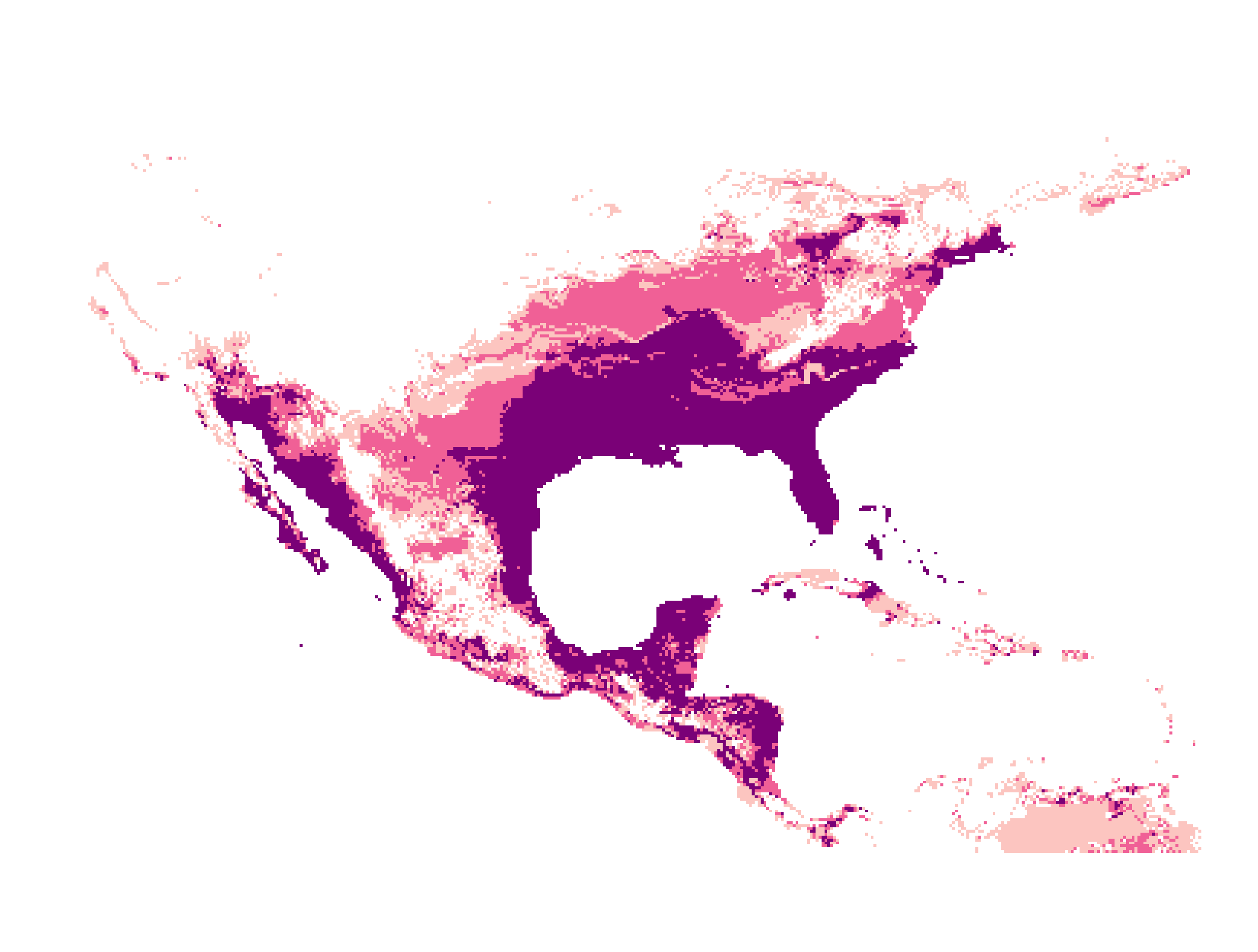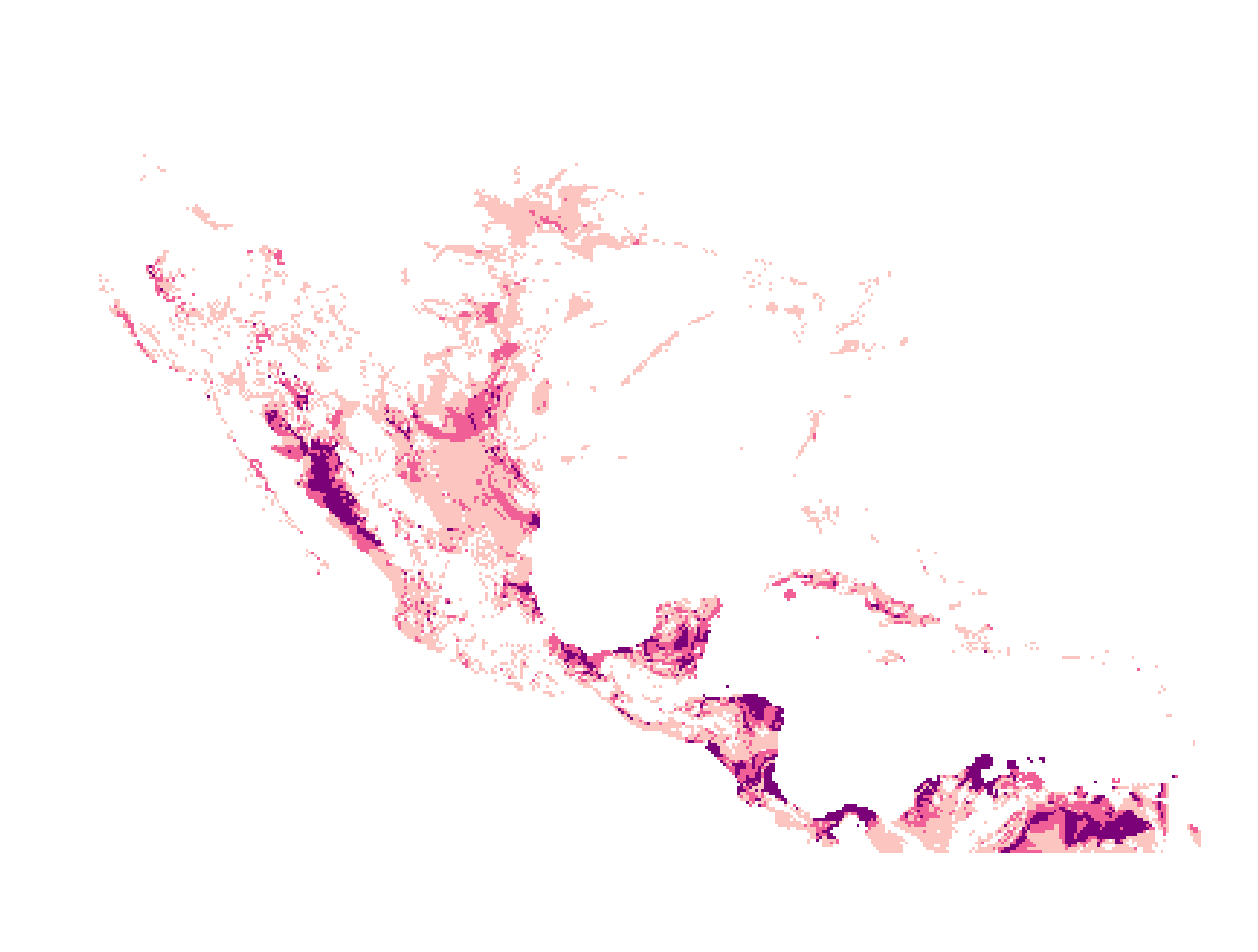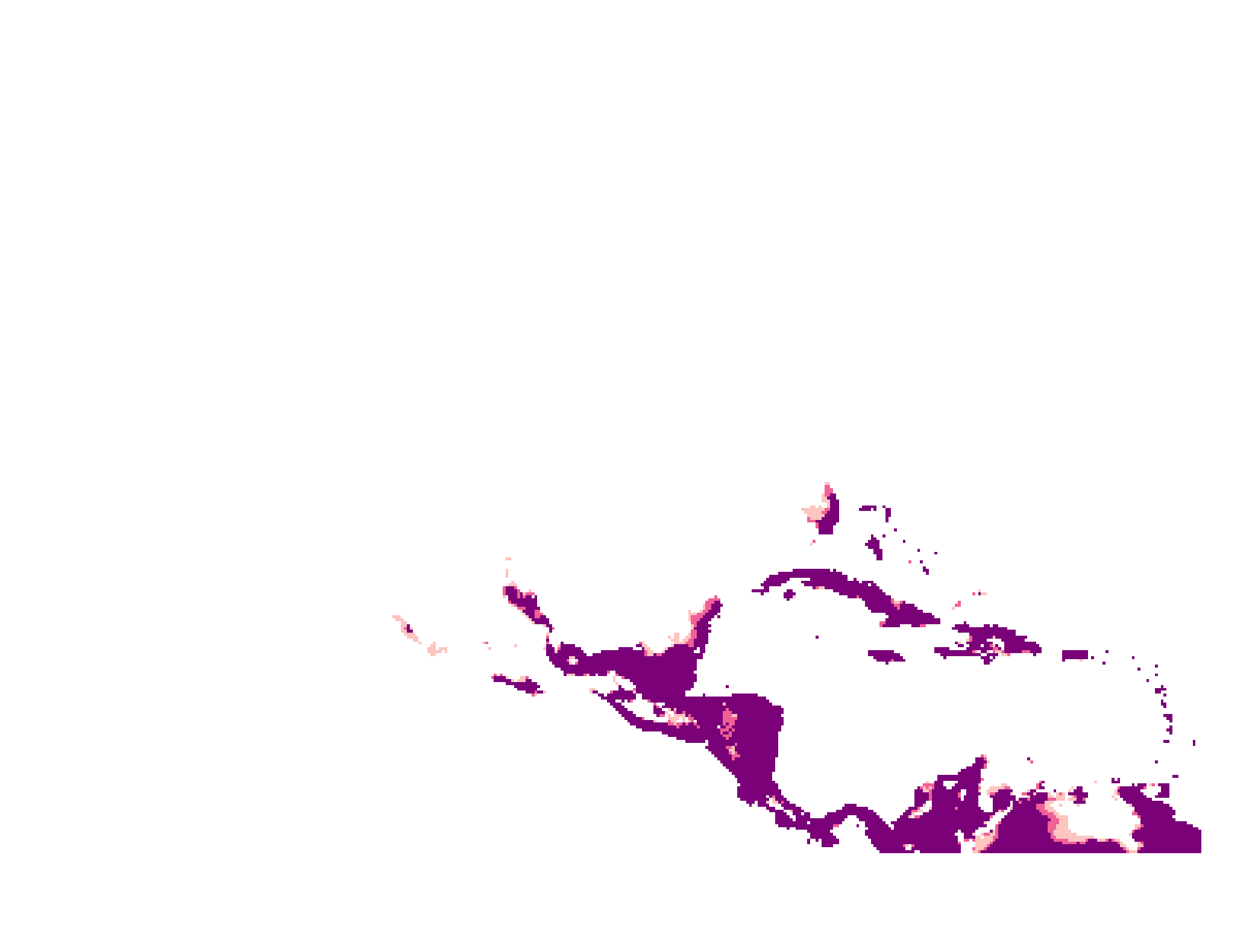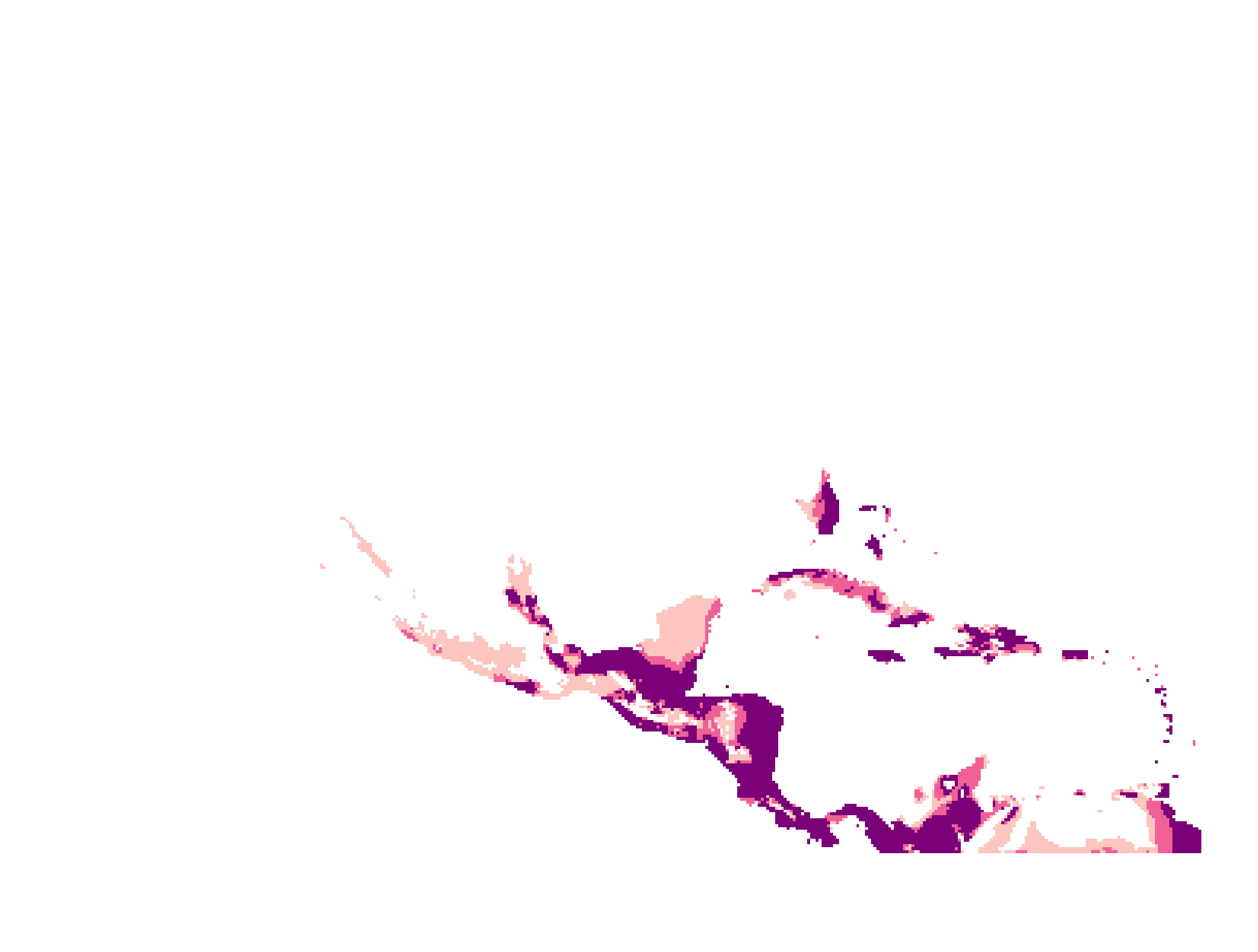Climate Envelope Modeling for Threatened and Endangered Species
Climate change is creating new challenges for biodiversity conservation. As temperatures, rainfall patterns, and sea levels change, distributions of plants and animals may shift geographically, altering their relationships with the environment and other species. As part of the response to climate change, the conservation community is starting to make decisions on longer time frames and with a focus on "adaptation" strategies to help species and habitats adjust. One of the first steps in adaptation planning is to conduct vulnerability assessments to identify which species or systems are likely to be most affected by climate change and why.
Climate envelope models are an important tool used in vulnerability assessments to help resource managers understand how plants and animals may respond to a changing climate. Climate envelope models describe the climate where a species currently lives (its climate "envelope"), and then map the geographic shift of that envelope under climate change. Because we can't know for certain how climate will change in the future, multiple climate change scenarios are used in these models.
Our future work will incorporate habitat data and other kinds of information into the models to refine projections for future distributions of threatened and endangered species. Well-validated models can provide information for natural resource planning by identifying species most at risk from climate change and highlighting areas of potential future conflict between human activities and conservation priorities. The climate envelope modeling project is a partnership among the University of Florida, U.S. Fish and Wildlife Service, U.S. Geological Survey, and National Park Service.
For more information about our work and our products, please take a look at the links included below, visit www.jem.gov, or send an email to Laura Brandt (laura_brandt@fws.gov), Frank Mazzotti (fjma@ufl.edu), Stephanie Romanach (sromanach@usgs.gov) or James Watling (watlingj@ufl.edu).
Interactive Map
This map shows climate envelopes for two endangered and three threatened animal species. Choose a species from the drop-down menu on the left, and click on the radio buttons to view its climate envelope for today, 2060, and 2100. The present-day climate envelope is defined based on the specific temperatures and rainfall patterns where the species currently exists. The future climate envelopes are estimated using data from three different general circulation models (GCMs), which are the models scientists use to make projections of future climate conditions. Future climate envelopes are shown on the map as predicted by one, two, or all three of the GCMs. The more the GCMs overlap, the more certain the prediction.Remember: The future climate envelope represents where a species may occur based on climate factors alone. That is, these maps do not consider the types of habitats, topography, or food sources each species needs to survive. For example, we would not expect American crocodiles, a coastal species, to turn up in the Midwest. Thus, these models serve best as initial screening tools to identify priority areas for further study.

Related Publications
Guidebook
Use and Interpretation of Climate Envelope Models: A Practical Guide (14.1MB PDF)
Posters
Incorporating Extremes into Climate Envelope Models for Florida Threatened and Endangered Vertebrates (877KB PowerPoint)
Modeling Effects of Anthropogenic Impact and Climate in the Distribution of Threatened and Endangered Species in Florida (2.29MB PowerPoint)
Using Ecological Traits to Evaluate the Vulnerability of Threatened and Endangered Species to Climate Change (979KB PDF)
Fact Sheets and Reports
Climate Change Adaptation: New Perspectives for Natural Resource Management and Conservation
Science Support for Climate Change Adaptation in South Florida
Climate Envelope Models in Support of Landscape Conservation (Final Report) (985KB PDF)
Articles
Bucklin, D.N., M. Basille, A.M. Benscoter, L.A. Brandt, F.J. Mazzotti, S.S. Romañach, C. Speroterra, J.I. Watling. 2015. Comparing species distribution models constructed with different subsets of environmental predictors. Diversity and Distributions 21 (1): 23–35.
Watling, J.I., L.A. Brandt, D.N. Bucklin, I. Fujisaki, F.J. Mazzotti, S.S. Romañach, C. Speroterra. 2015. Performance metrics and variance partitioning reveal sources of uncertainty in species distribution models. Ecological Modelling 309–310 (August): 48–59.
Watling, J.I., R.J. Fletcher, C. Speroterra, D.N. Bucklin, L.A. Brandt, S.S. Romañach, L.G. Pearlstine, Y. Escribano, F.J. Mazzotti. 2014. Assessing effects of variation in global climate data sets on spatial predictions from climate envelope models. Journal of Fish and Wildlife Management 5 (1): 14–25.
Bucklin, D.N., J.I. Watling, C. Speroterra, L.A. Brandt, F.J. Mazzotti, S.S. Romañach. 2013. Climate downscaling effects on predictive ecological models: a case study for threatened and endangered vertebrates in the southeastern United States. Regional Environmental Change 13 (1): 57–68.
Watling, J.I., S.S. Romañach, D.N. Bucklin, C. Speroterra, L.A. Brandt, L.G. Pearlstine, F.J Mazzotti. 2012. Do bioclimate variables improve performance of climate envelope models? Ecological Modelling 246: 79-85. (Click here to download the R code used to create models in this paper.)
NetCDF Files
Readme file (for information on the NetCDF files and how to use them)
Ambystoma cingulatum [5.66 MB]
Ammodramus maritimus mirabilis [6.45 MB]
Ammodramus savannarum floridanus [6.62 MB]
Aphelocoma coerulescens [6.19 MB]
Crocodylus acutus (coastal) [7.11 MB]
Drymarchon corais couperi [7.68 MB]
Eumeces egregius lividus [5.72 MB]
Grus americana (non-migratory Florida population) [9.82 MB]
Microtus pennsylvanicus dukecampbelli (coastal) [7.54 MB]
Neotoma floridana smalli [5.82 MB]
Nerodia clarkii taeniata (coastal) [5.89 MB]
Odocoileus virginianus clavium [10.1 MB]
Oryzomys argentatus (coastal) [6.89 MB]
Peromyscus gossypinus allapaticola [6.35 MB]
Peromyscus polionotus niveiventris (coastal) [6.91 MB]
Peromyscus polionotus phasma (coastal) [6.91 MB]
Polyborus plancus audubonii [7.95 MB]
Rhostramus sociabilis plumbeus [7.62 MB]
